NLTK
Last updated
Jun 17, 2023
https://www.nltk.org/book/
# Introduction
natural language toolkit, python 库
# help
1
2
|
nltk.help.upenn_tagset('DT')
nltk.help.brown_tagset('DT')
|
根据输入的语法规则, 分析给定句子的结构
syntax analyse 的任务主要是两种
- Strukturkennung 结构识别: 句子是否符合语法/是否有一种符合规则的推导
- Strukturzuweisung 结构分配: 重现找到的语法推导
# Grammar types in NLTK
lmu - Syntax of natural language(Germany)
sent = [‘I’, ‘shot’, ‘an’, ’elephant’, ‘in’, ‘my’, ‘pajamas’]
1
|
sent = "I shot an elephant in my pajamas.".split()
|
# 用 CFG 生成句子
- nltk.CFG.fromstring
- nltk.ChartParser/nltk.RecursiveDescentParser
1
2
3
4
5
6
7
8
9
10
11
12
13
14
15
16
17
18
|
# 语法输入
grammar = nltk.CFG.fromstring("""
S -> NP VP
PP -> P NP
NP -> Det N | Det N PP | Pron
VP -> V NP | VP PP
Pron -> 'I'
Det -> 'an' | 'my'
N -> 'elephant' | 'pajamas'
V -> 'shot'
P -> 'in'
""")
# 根据语法创建解析器
parser = nltk.ChartParser(grammar) # ops: trace=3
# 可视化结果
for tree in parser.parse(sent):
tree.pretty_print(unicodelines=False)
|
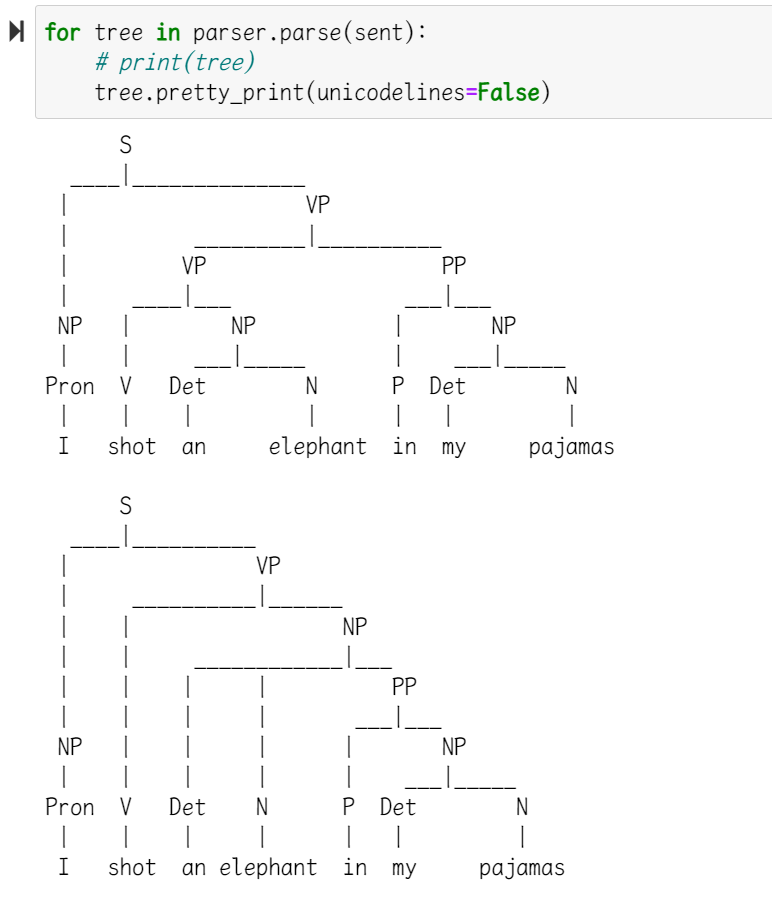
PCFG
- nltk.PCFG.fromstring
- nltk.ViterbiParser
FCFG
- 基于 RegExp
- grammar = string
- nltk.grammar.FeatureGrammar.fromstring
- nltk.parse.FeatureChartParser
详参 01-vorlesung.ipynb
# 给定语法规则生成不同句子
1
2
3
4
5
6
7
8
9
10
11
12
13
14
15
16
17
18
|
grammar = nltk.CFG.fromstring("""
S -> NP VP
VP -> 'V' | 'V' NP | 'V' NP NP
NP -> 'DET' 'N' | 'N'
""")
from nltk.parse.generate import generate
# depth=3: 使用三次规则
for sentence in generate(grammar, depth=3):
print(' '.join(sentence))
# out:
# DET N V
# N V
# 有多少种?
print(len(list(generate(grammar, depth=3)))
# out:
# 2
|
# grammar.productions()
1
2
3
4
5
6
7
8
9
|
grammar = nltk.CFG.fromstring("""
S -> NP VP
VP -> 'V' | 'V' NP | 'V' NP NP
NP -> 'DET' 'N' | 'N'
""")
# 会把规则一条一条打印出来
for p in grammar.productions():
print(p)
|
out:
1
2
3
4
5
6
|
S -> NP VP
VP -> 'V'
VP -> 'V' NP
VP -> 'V' NP NP
NP -> 'DET' 'N'
NP -> 'N'
|
# 用 Dependcy Grammar 生成句子
- nltk.DependencyGrammar.fromstring
- nltk.ProjectiveDependencyParser
1
2
3
4
5
6
7
8
9
10
|
#Dependency Grammar (unlabeled):
grammar = nltk.DependencyGrammar.fromstring("""
'shot' -> 'I' | 'elephant' | 'in'
'elephant' -> 'an' | 'in'
'in' -> 'pajamas'
'pajamas' -> 'my'
""")
parser = nltk.ProjectiveDependencyParser(grammar)
for tree in parser.parse(sent):
tree.pretty_print()
|
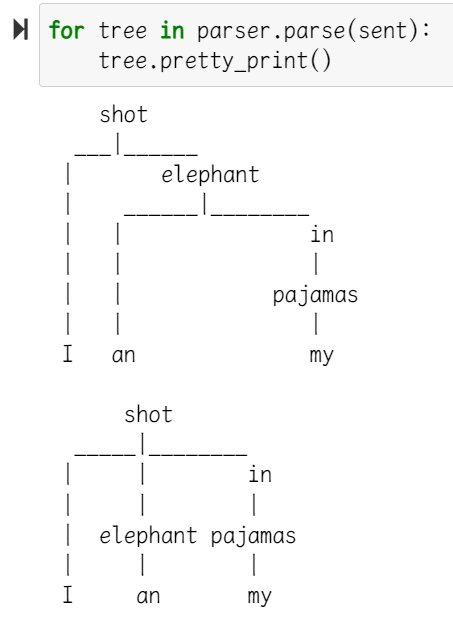
# 用 Chunk Parser 生成句子
- regexp
- nltk.RegexpParser(grammar)
1
2
3
4
5
6
7
8
9
10
11
12
|
# partielle, flache RegExp-Grammatik:
grammar = r"""
NP: {<DET>?<ADJ>*<N>}
{<PRON>}
PP: {<P>}
"""
sent = [("I", "PRON"), ("shot", "V"), ("an", "DET"), ("elephant", "N"),
("in", "P"), ("my", "DET"), ("pajamas", "N")]
parser = nltk.RegexpParser(grammar)
tree = parser.parse(sent)
tree.pretty_print()
|
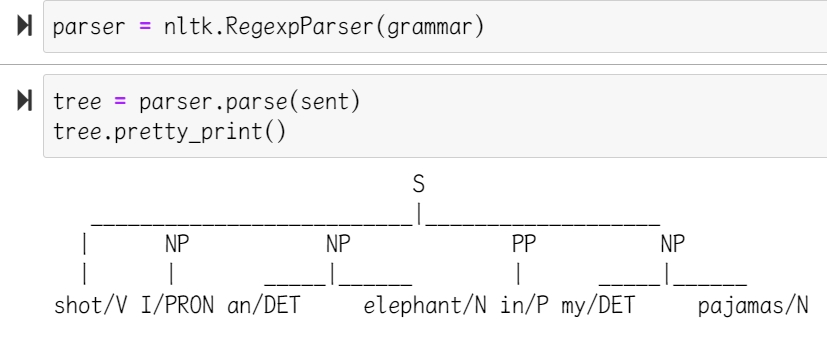
# Constituent Tests
# 用 CFG 进行删除测试
lmu - Syntax of natural language(Germany)
- 给定原句的 syntaktische 和 lexicalische 规则
- 确保原句可以按 这里这样生成树.
- 输入的句子用删除后的句
详参
vorlesung-notebook/04-vorlesung.ipynb
# 用 Feature-based语法生成句子
- nltk.grammar.FeatureGrammar.fromstring()
- nltk.parse.FeatureChartParser()
1
2
3
4
5
6
7
8
9
10
11
12
13
14
15
16
17
18
19
20
|
# tracing = 0/2
grammar = nltk.grammar.FeatureGrammar.fromstring(gramstring)
parser = nltk.parse.FeatureChartParser(grammar,trace=tracing)
## POS Tagging
#### 使用指定 tagset 标记指定 text
```python
import nltk
text = "We want to tag the words in this text example."
tokens = nltk.word_tokenize(text)
tags1 = nltk.pos_tag(tokens) # Penn?
tags2 = nltk.pos_tag(tokens, tagset="universal")
print(tags1)
print(tags2)
|
1
2
3
|
out:
[('We', 'PRP'), ('want', 'VBP'), ...]
[('We', 'PRON'), ('want', 'VERB'), ...]
|
# Distribution Analyse
常用来确认词的类别
1
2
3
|
# 加载 Text
from nltk.corpus import brown
text = nltk.Text(word.lower() for word in nltk.corpus.brown.words())
|
# similar()
1
2
|
# text.similar(w) 找出与 w 上下文相同的词
text.similar('woman')
|
# 读取 corpus 中自带的 tag
1
2
|
from nltk.corpus import brown
brown_tagged = brown.tagged_words(categories='news', tagset='universal')
|
# 句子结构分析
# Dependency Graph
1
2
3
4
5
6
7
8
9
10
|
sent = """John N 2
loves V 0
Mary N 2
"""
dg = DependencyGraph(sent)
tree = dg.tree()
print(tree)
tree.pretty_print(unicodelines=False)
|
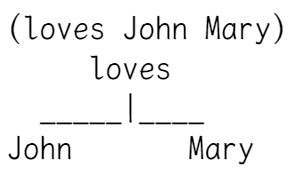
IPython.display(), 需要 pip install svgling 包
1
2
|
from IPython.display import display
display(dg)
|
# Feature-based 结构
# 创建 FeatStruct
第一种
1
2
3
4
5
|
import nltk
from nltk import Tree
from nltk import FeatStruct
fs1 = FeatStruct(number='singular', person=3, )
print(fs1)
|
out:
1
2
|
[ number = 'singular' ]
[ person = 3 ]
|
1
2
|
fs2 = FeatStruct(type='NP', agr=fs1)
print(fs2)
|
out:
1
2
3
4
|
[ agr = [ number = 'singular' ] ]
[ [ person = 3 ] ]
[ ]
[ type = 'NP' ]
|
第二种
1
2
3
4
|
# folgen
FeatStruct("[CAT=V, LEMMA=folgen,"+
"SYN=[SBJ=?x, OBJ=?y],"+
"SEM=[AGT=?x, PAT=?y]]")
|
# Unifikation
- 返回将两个 Feat Struct 统一成的结构, 或者 None
- 只有在两个结构(的内容)不冲突时才能成功
上接
1
2
|
fs3 = FeatStruct(agr=FeatStruct(number=Variable('?n')), subj=FeatStruct(number=Variable('?n'))) # 变量n
print(fs3)
|
out:
1
2
3
|
[ agr = [ number = ?n ] ]
[ ]
[ subj = [ number = ?n ] ]
|
out:
1
2
3
4
5
6
|
[ agr = [ number = 'singular' ] ]
[ [ person = 3 ] ]
[ ]
[ subj = [ number = 'singular' ] ]
[ ]
[ type = 'NP' ]
|
# 创建 Feature 语法
1
2
3
4
5
6
7
8
9
10
11
12
13
|
#Feature-Grammar NP-Agreement:
gramstring = r"""
% start NP
NP[AGR=?x] -> DET[AGR=?x] N[AGR=?x]
N[AGR=[NUM=sg, GEN=mask]] -> "Hund"
N[AGR=[NUM=sg, GEN=fem]] -> "Katze"
DET[AGR=[NUM=sg, GEN=mask, CASE=nom]] -> "der"
DET[AGR=[NUM=sg, GEN=mask, CASE=akk]] -> "den"
DET[AGR=[NUM=sg, GEN=fem]] -> "die"
"""
|
然后就可以用这个语法分析句子了, notebook/06-vorlesung 中有例子
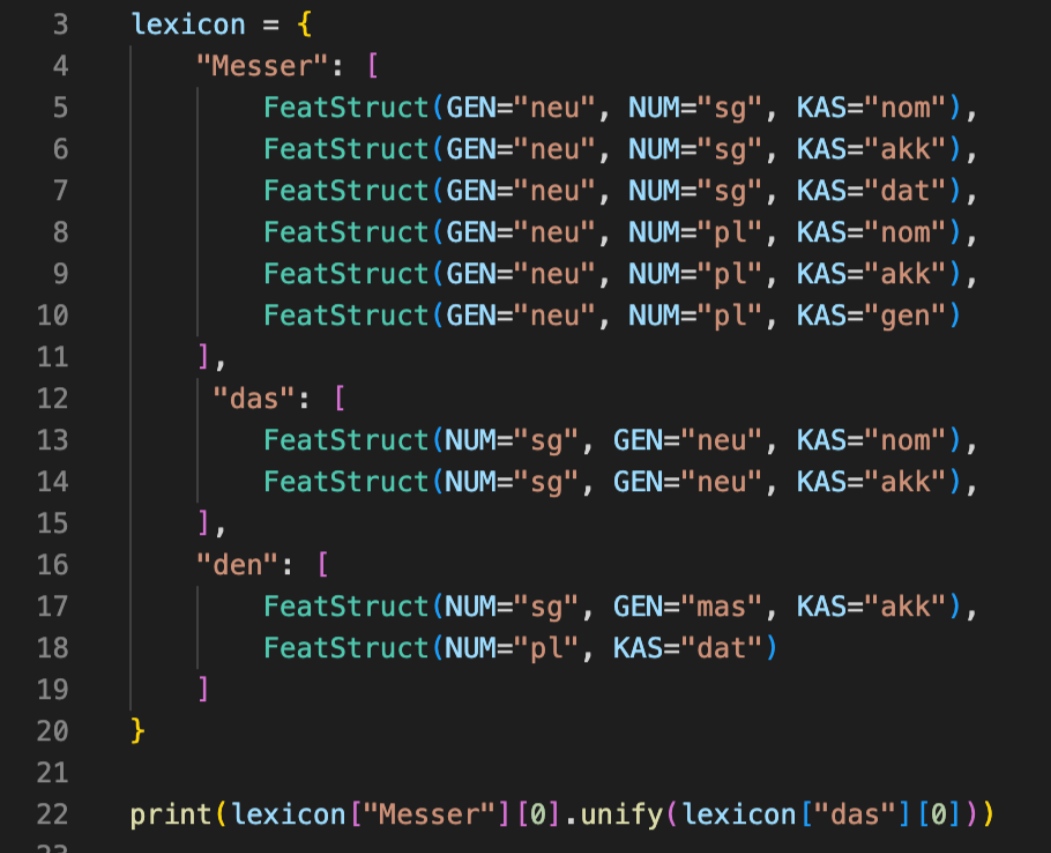 out:
out:
1
2
3
|
[ GEN = 'neu' ]
[ NUM = 'sg' ]
[ KAS = 'nom' ]
|
# GPSG
- Generalized Phrase Structure Grammar
- 在 中, 标注 V 的子类型
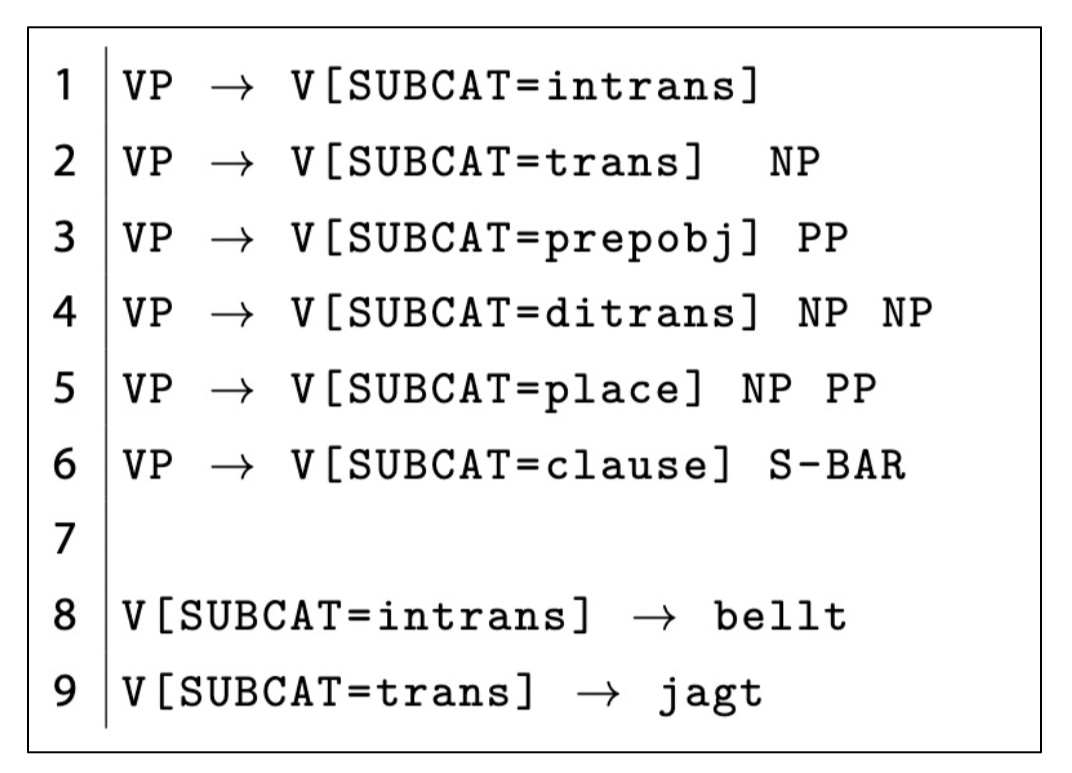
# HPSG
- Head-driven Phrase Structure Grammar
- 给动词 Feature-based 框架里标注上相关信息
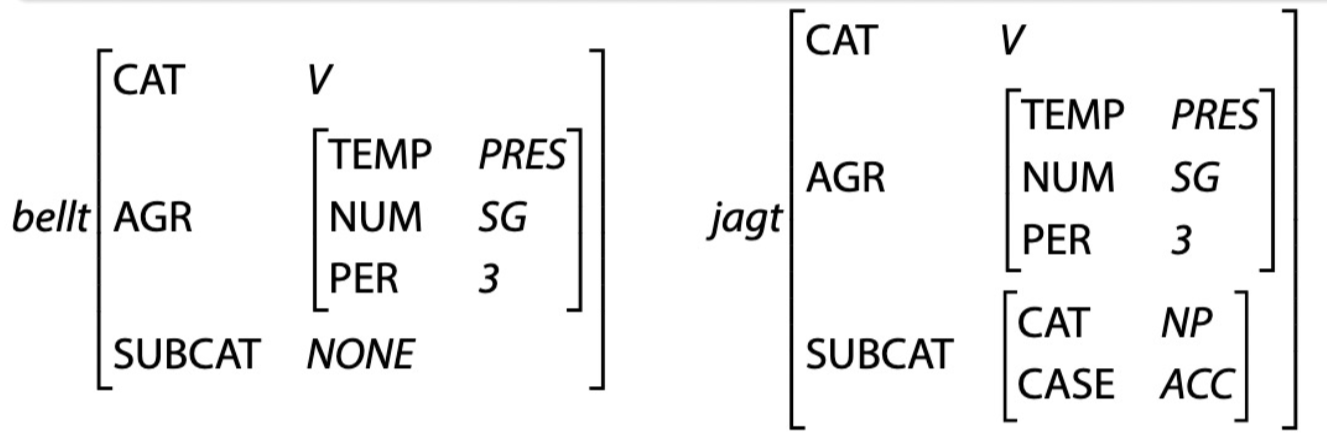
# 如何得到句子的的动词 FeatStruct
1
2
3
4
5
6
7
8
9
10
11
12
13
14
15
16
17
18
19
20
|
import spacy
nlp = spacy.load('de_core_news_sm')
# In: sentence as a string
# Out: semantic feature structure
def semantic_parse(sentence):
sbj, obj, verb = None, None, None
analyzed = nlp(sentence)
for token in analyzed:
if token.dep_ == 'sb':
sbj = token.text
elif token.dep_ == 'oa' or token.dep_ == 'da':
obj = token.text
elif token.pos_ == 'VERB':
verb = token.lemma_
if sbj is None or obj is None or verb is None:
raise RuntimeError('I could not identify all relevant parts: {} - {} - {}'.format(sbj, verb, obj))
return lexicon[verb].unify(
FeatStruct(SYN=FeatStruct(SBJ=sbj, OBJ=obj))
)
|
1
2
3
4
5
|
for sent in sentences:
fs = semantic_parse(sent)
print()
print(sent)
print(fs)
|
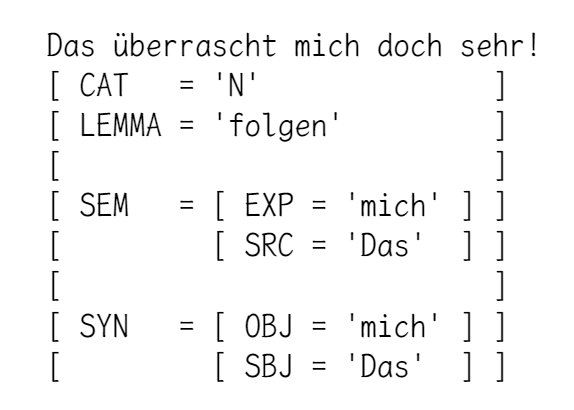
1
2
3
4
5
6
7
8
|
from spacy import displacy
for sentence in sentences:
sent = nlp(sentence)
for token in sent:
print(token.text, token.lemma_, token.pos_, token.tag_, token.dep_,
token.shape_, token.is_alpha, token.is_stop, sep='\t')
displacy.render(sent, style='dep', options={'distance':100})
|
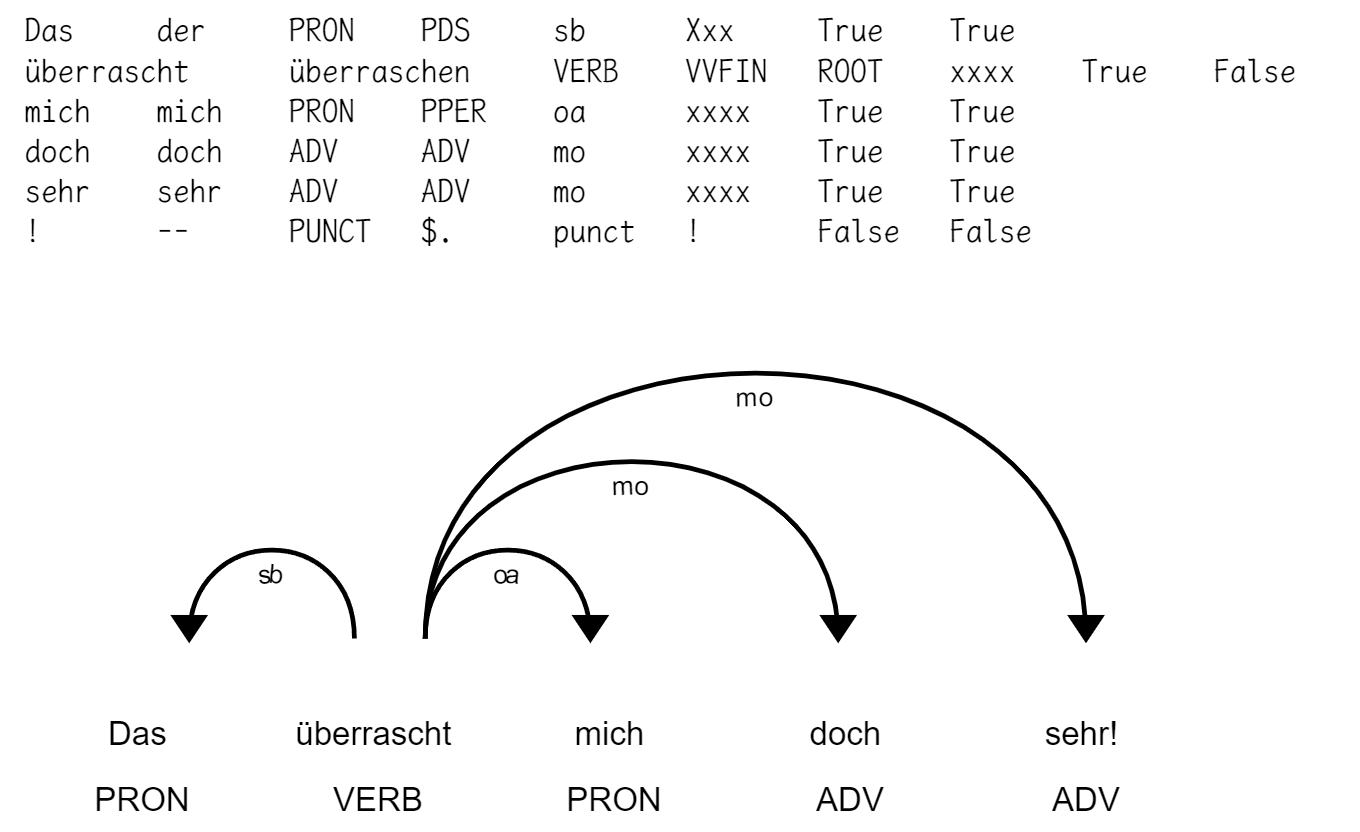
# Subsumption
- f1.subsumes(f2), 返回 True/False
- f1 的内容 f2 也有
# Parsers
PCFG(u12)
1
2
3
4
5
6
7
8
9
10
11
12
13
14
15
16
17
18
19
20
21
22
23
24
25
26
27
28
29
30
|
# 根据 treebank 中的 parsed_sents() 为输入, 推测 带权重的语法规则
# Production count: the number of times a given production occurs
pcount = defaultdict(int)
# LHS-count: counts the number of times a given lhs occurs
lcount = defaultdict(int)
for tree in treebank.parsed_sents():
for p in tree.productions():
pcount[p] += 1
lcount[p.lhs()] += 1
productions = [
ProbabilisticProduction(
p.lhs(), p.rhs(),
prob = pcount[p] / lcount[p.lhs()] # TODO
)
for p in pcount
]
# test
start = nltk.Nonterminal('S')
grammar = PCFG(start, productions)
parser = nltk.ViterbiParser(grammar)
for s in test_sentences:
for t in parser.parse(nltk.word_tokenize(s)):
print(t.prob())
t.pretty_print(unicodelines=False)
|




 out:
out:


